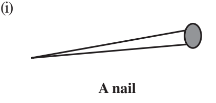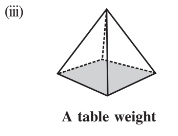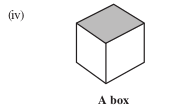NCERT Solutions for Class 8 Maths Chapter 10 Visualizing Solid Shapes
Visualizing Solid Shapes Class 8 Questions And Answers provided here. These NCERT Solutions are created by expert team at Craeers360 keeping in mind of the latest syllabus and pattern of CBSE 2023-23. In this NCERT solutions for Class 8 Maths chapter 10 Visualizing Solid Shapes you will study solid objects like cubes, cuboids, cones, spheres, hemispheres, etc. You must have noticed that 3-dimensional objects look different when you look from different positions or different angles. To simplify its study there are defined viewpoints (front view, side view, top view) for the 3D object.
This Story also Contains
- Visualizing Solid Shapes Class 8 Questions And Answers PDF Free Download
- Visualizing Solid Shapes Class 8 Solutions - Important Formulae
- Visualizing Solid Shapes Class 8 NCERT Solutions (Intext Questions and Exercise)
- Picture (object)
- Shape
- (i) An agricultural field
- NCERT Solutions for Class 8 Maths Chapter 10 Visualizing Solid Shapes - Topics
- NCERT Solutions for Class 8 Maths - Chapter Wise
- Key Features Of NCERT Solutions for Class 8 Maths Chapter 10 Visualizing Solid Shapes
- NCERT Solutions for Class 8 - Subject Wise
- NCERT Books and NCERT Syllabus
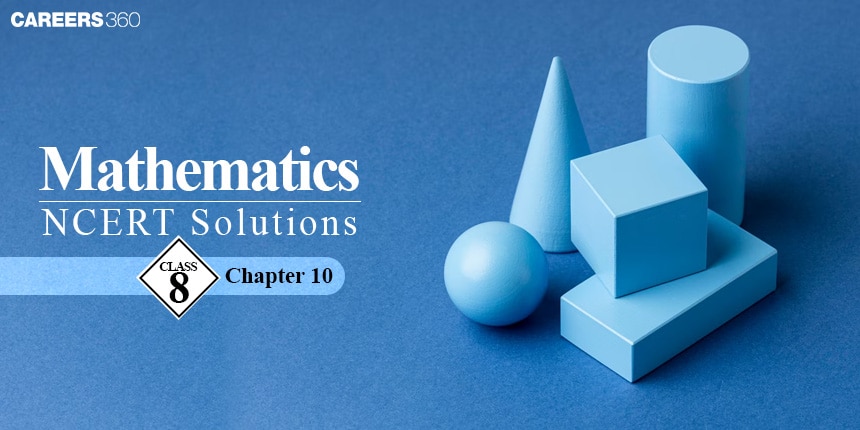
In NCERT solutions for Class 8 Maths chapter 10 Visualizing Solid Shapes, maximum questions are related to finding front view, side view, and top view of the 3D geometry. Important topics like views of 3D shapes, mapping space around us, faces, edges, and vertices of the objects are covered in this chapter. NCERT solutions for Class 8 Maths chapter 10 Visualizing Solid Shapes are very helpful in engineering drawing, locating the place and will build a basic understanding of the 3D shapes. Here you will get the detailed NCERT Solutions for Class 8 Maths by clicking on the link.
Visualizing Solid Shapes Class 8 Questions And Answers PDF Free Download
Visualizing Solid Shapes Class 8 Solutions - Important Formulae
Polyhedron: A solid object bordered by polygons (platonic solid).
Euler's Formula: For a polyhedron with F faces, V vertices, and E edges:
F + V - E = 2
Prism: A solid with parallelogram side faces and congruent parallel polygon ends (bases). A prism consists of two triangular faces, three rectangular faces, six vertices, and nine edges.
Pyramid: A polyhedron with a polygonal base and additional triangular faces converging at a common vertex. A pyramid typically consists of one square face, four triangular faces, five vertices, and eight edges.
Tetrahedron: A type of triangular pyramid where the base is a triangle.
Dimensions of a Solid: Three-dimensional objects have three measurements (length, width, and height), while two-dimensional objects have two measurements (length and breadth or depth).
Mapping: Maps are different from photographs, as they show the relationships between objects and locations using symbols and a set scale.
Faces, Vertices, and Edges: In a polyhedron, faces are polygonal sections, edges are line segments connecting faces, and vertices are the points where edges intersect.
Free download NCERT Solutions for Class 8 Maths Chapter 10 Visualizing Solid Shapes for CBSE Exam.
Visualizing Solid Shapes Class 8 NCERT Solutions (Intext Questions and Exercise)
Visualizing solid shapes class 8 NCERT solutions - Topic 10.1 Introduction
Question:1 Match the following: (First one is done for you)

Answer:
Matched items are:

Question:2 Match the following pictures (objects) with their shapes:
Picture (object)
Shape
(i) An agricultural field

Two rectangular cross paths inside a rectangular park.

A circular path around a circular ground.
(iii) A toy

A triangular field adjoining a square field.
(iv) A circular park

A cone has been taken out of a cylinder.
(v) A cross path

A hemisphere surmounted on a cone.
Answer:
Matched objects are: 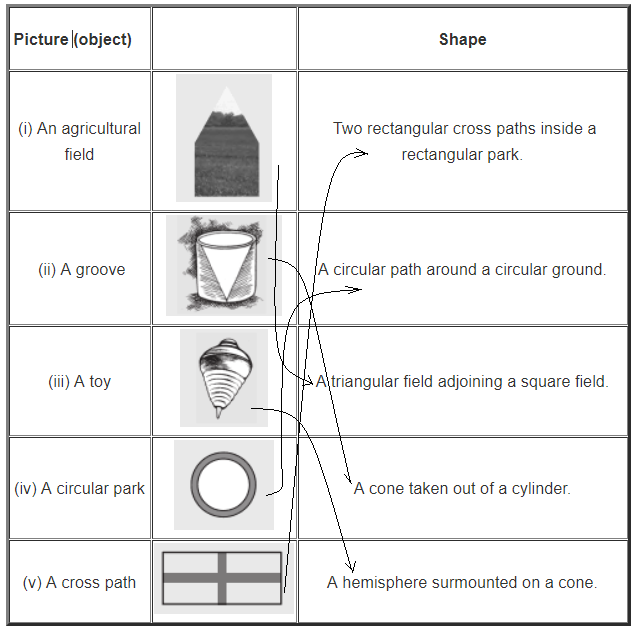
Class 8 maths chapter 10 question answer - exercise: 10.1
Object Side view Top view
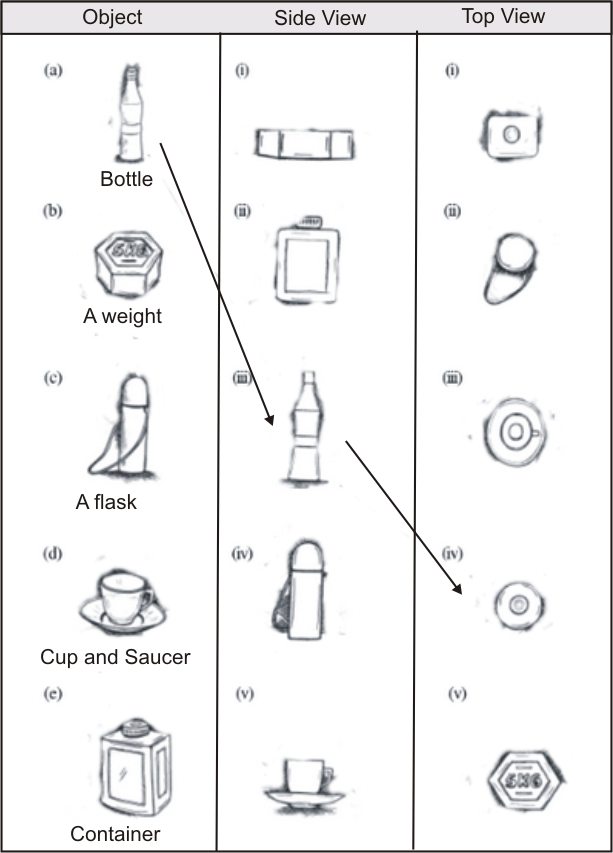
Answer:
Matched objects are:
(1) →iii)→iv)
(2) →i) →v)
(3) →iv)→ii)
(4) →v) →iii)
(5) →ii) →i)

Question:2(a) For each of the given solid, the three views are given. Identify for each solid the corresponding top,
front and side views.
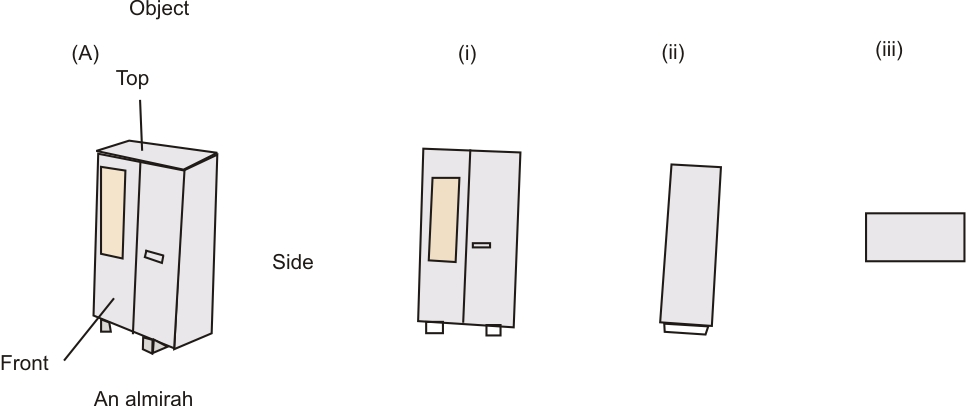 Answer:
Answer:
(a) Different views have given: (i) Front, (ii) Side, (iii) Top.

Question:2(b) For each of the given solid, the three views are given. Identify for each solid the corresponding top,
front and side views. 
Answer:
(b) (i) Side view, (ii) Front view, (iii) Top view.

Question:2(c) For each of the given solid, the three views are given. Identify for each solid the corresponding top,
front and side views. 
Answer:
(c) (i) Front view, (ii) Side view, and (iii) Top view.

Question:2(d) For each of the given solid, the three views are given. Identify for each solid the corresponding top,
front and side views.

Answer:
(d) (i) Front view, (ii) Side view, and (iii) Top view.

Question:3(a) For each given solid, identify the top view, front view and side view.

Answer:
(a) (i) Top view, (ii) Front/ Side view, and (iii) Side/ Front view.
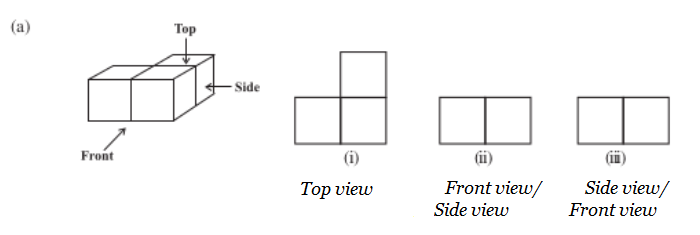
Question:3(b) For each given solid, identify the top view, front view and side view.

Answer:
(b) (i) Side view, (ii) Front view, and (iii) Top view.

Question:3(c) For each given solid, identify the top view, front view and side view.

Answer:
(c) (i) Top view, (ii) Side view, and (iii) Front view.

Question:3(d) For each given solid, identify the top view, front view and side view.

Answer:
(d) (i) Side view, (ii) Front view, and (iii) Top view.

Question:3(e) For each given solid, identify the top view, front view and side view.
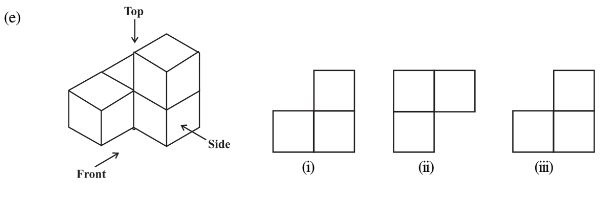
Answer:
(e) (i) Front view, (ii) Top view, and (iii) Side view.

Question:4(a) Draw the front view, side view and top view of the given objects.
A military tent 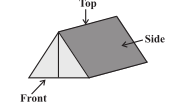
Answer:
The front view, top view, and side view of a tent are shown below:
The front view, top view, and side view of a tent are shown below:
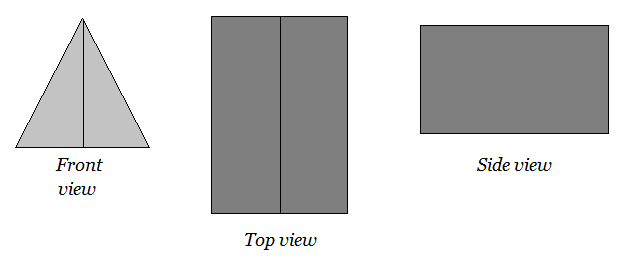
Question:4(b) Draw the front view, side view and top view of the given objects.
A table
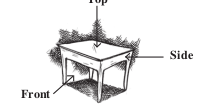
Answer:
The front view, top view, and Side view of the table are shown below: 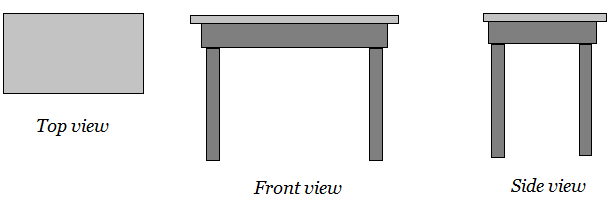
Question:4(c) Draw the front view, side view and top view of the given objects.
A nut 
Answer:
The front, top, and side views of the nut are:

Question:4(d) Draw the front view, side view and top view of the given objects.
A hexagonal block 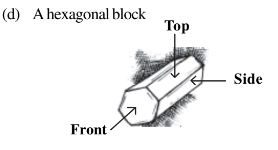
Answer:
The front view, side view and top view of the hexagonal block are shown below:
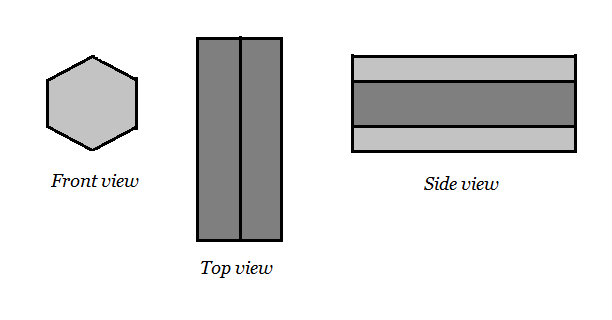
Question:4(e) Draw the front view, side view and top view of the given objects. 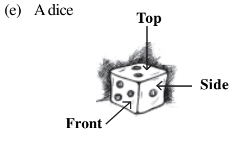
Answer:
The front view, side view and top view of the dice as shown below:
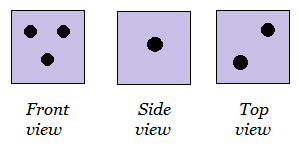
Question:4(f) Draw the front view, side view and top view of the given objects.
A solid
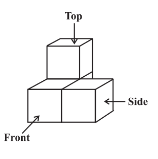
Answer:
The front view, side view and top view of the given solid. 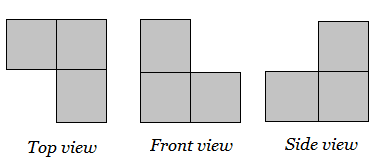
Class 8 maths chapter 10 ncert solutions - exercise: 10.2
Question:1(a) Look at the given map of a city.
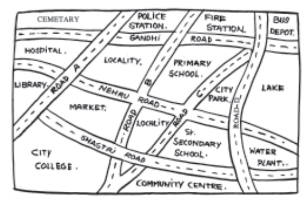
Answer the following.
Colour the map as follows: Blue-water, red-fire station, orange-library, yellow
schools, Green - park, Pink - College, Purple - Hospital, Brown - Cemetery.
Answer:
(a) Coloured map shown:
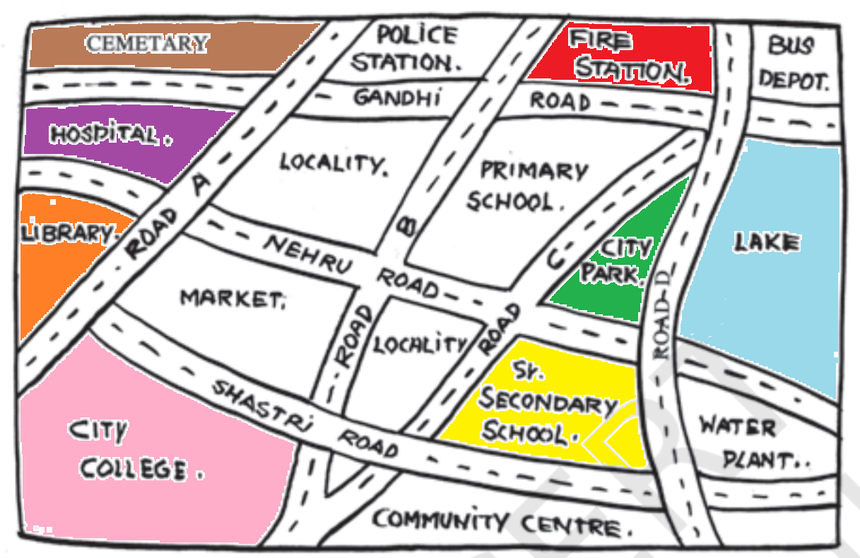
Question:1(b) Look at the given map of a city.
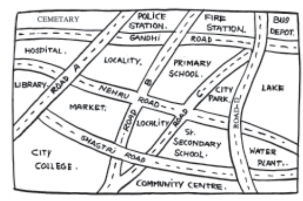
Answer the following.
Mark a green ‘X’ at the intersection of Road ‘C’ and Nehru Road, Green ‘Y’ at the intersection of Gandhi Road and Road A.
Answer:
(b) marked points of intersections "X" and "Y":

Question:1(c) Look at the given map of a city. 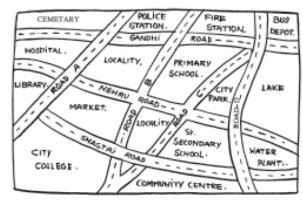
Answer the following.
In red, draw a short street route from Library to the bus depot.
Answer:
Route from Library to bus depot is shown:

Question:1(d) Look at the given map of a city.
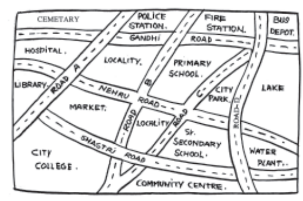
Answer the following.
Which is further east, the city park or the market?
Answer:
(d) The city park is further east.
Question:1(e) Look at the given map of a city. 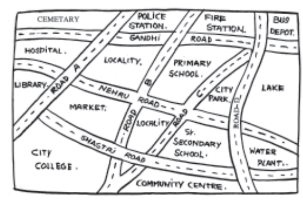
Answer the following.
Which is further south, the primary school or the Sr. Secondary School?
Answer:
(e) Sr. Secondary School is further south.
Question:2 Draw a map of your class room using proper scale and symbols for different objects.
Answer:
Do it yourself.
Answer:
Do it with your own imagination.
Question:4 Draw a map giving instructions to your friend so that she reaches your house without any difficulty.
Answer:
Do it with your own imagination.
NCERT Solutions for Class 8 Maths Chapter 10 Visualizing Solid Shapes - Topic 10.4 Faces, Edges and Vertices
Solid | F | V | E | F+V | E+2 |
|---|---|---|---|---|---|
Cuboid | |||||
Triangular pyramid | |||||
Triangular prism | |||||
Pyramid with square base | |||||
Prism with square base |
Answer:
Cuboid | 6 | 8 | 12 | 14 | 14 |
Triangular pyramid | 4 | 4 | 6 | 8 | 8 |
Triangular prism | 5 | 6 | 9 | 11 | 11 |
Pyramid with square base | 5 | 5 | 8 | 10 | 10 |
Prism with square base | 6 | 8 | 12 | 14 | 14 |
Solid | F | V | E | F+V | E+2 |
|---|
Class 8 visualizing solid shapes ncert solutions - exercise: 10.3
Question:1(i) Can a polyhedron have for its faces
3 triangles?
Answer:
(i) No, a polyhedron cannot have 3 triangles for its faces .
Question:1(ii) Can a polyhedron have for its faces
4 triangles?
Answer:
(ii) Yes, a polyhedron having 4 triangles is pyramid on triangular base.
Question:1(iii) Can a polyhedron have for its faces
a square and four triangles?
Answer:
(iii) Yes, a polyhedron can have faces of a square and four triangles which makes a pyramid on square base.
Question:2 Is it possible to have a polyhedron with any given number of faces? (Hint: Think of a pyramid).
Answer:
Yes , it is possible if the number of faces is four or more than four.
Question:3(ii) Which are prisms among the following? 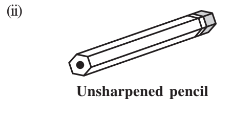
Answer:
(ii) The unsharpened pencil is a prism.
Question:4(i) How are prisms and cylinders alike?
Answer:
(i) A prism is a polyhedron whose base and top are congruent polygons and whose other faces, i.e., lateral faces are parallelograms in shape. Also, the cylinder has base on top and bottom and faces are parallel.
Question:5 Is a square prism same as a cube? Explain.
Answer:
No , not always, because it can be a cuboid also when extended.
Question:6(i) Verify Euler’s formula for these solids.
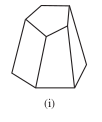
Answer:
(i) Euler formula F+V = E + 2.
So, Number of faces (F) = 7, Number of vertices (V) = 10 and number of edges (E) = 15.
Hence putting in the formula; we get,
7 + 10 = 15 + 2
17 = 17 hence, it satisfies the Euler formula.
Question:6(ii) Verify Euler’s formula for these solids. 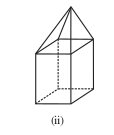 Answer:
Answer:
(ii) Euler formula F+V = E + 2.
So, Number of faces (F) = 9, Number of vertices (V) = 9 and number of edges (E) = 16.
Hence putting in the formula; we get,
9 + 9 = 16 + 2
18 = 18 hence, it satisfies the Euler formula.
Question:7 Using Euler’s formula find the unknown.
 Answer:
Answer:
We know the Euler Formula:
F + V = E + 2 :
hence we can easily find the unknown let say 'F, V, and E'
So, For Ist case:
F + 6 = 12 + 2 or F = 8, hence the number of faces in Ist case is 8.
For IInd Case;
5 + V = 9 + 2 or V = 6, hence the number of vertices in IInd case is 6.
For IIIrd case;
20 + 12 = E + 2 or E = 30, hence the number of Edges in the IIIrd case is 30.
Faces | 8 | 5 | 20 |
Vertices | 6 | 6 | 12 |
Edges | 12 | 9 | 30 |
Question:8 Can a polyhedron have 10 faces, 20 edges and 15 vertices?
Answer:
Checking using Euler's Formula:
F + V = E +2;
Given that F = 10, V = 15 and E = 20 so,
Putting in equation: 10 + 15 = 35 and 20 +2 = 22
Hence, given polyhedron having 10 faces, 20 edges and 15 vertices is not possible.
NCERT Solutions for Class 8 Maths Chapter 10 Visualizing Solid Shapes - Topics
- Views of 3D-Shapes
- Mapping Space Around Us
- Faces, Edges, and Vertices
NCERT Solutions for Class 8 Maths - Chapter Wise
Chapter -1 | |
Chapter -2 | |
Chapter-3 | |
Chapter-4 | |
Chapter-5 | |
Chapter-6 | |
Chapter-7 | |
Chapter-8 | |
Chapter-9 | |
Chapter-10 | Visualizing Solid Shapes |
Chapter-11 | |
Chapter-12 | |
Chapter-13 | |
Chapter-14 | |
Chapter-15 | |
Chapter-16 |
Key Features Of NCERT Solutions for Class 8 Maths Chapter 10 Visualizing Solid Shapes
Comprehensive Coverage: Solutions for maths chapter 10 class 8 cover all topics and concepts related to visualizing solid shapes as per the Class 8 syllabus.
Step-by-Step Solutions: Detailed, step-by-step explanations for each problem, making it easy for students to understand and apply mathematical concepts related to three-dimensional shapes.
Illustrations and Diagrams: These class 8 maths ch 10 question answer includes diagrams, figures, and illustrations to visually explain the properties, views, and representations of solid shapes.
NCERT Solutions for Class 8 - Subject Wise
In NCERT solutions for class 8 maths chapter 10 visualizing solid shapes only one formula has been used know as Euler’s formula.
For any polyhedron-
$F+V-E=2$
where F - Number of faces
V - Number of vertices
E - Number of edges
As the name suggests this chapter is more about visualizing the shapes and drawing the front view, side view, and top view. In exercise 1 and 2 of NCERT solutions for class 8 maths chapter 10 visualizing solid shapes, most questions are related to visualizing shape and mapping which are explained with the help of drawing and graphs.
NCERT Books and NCERT Syllabus
Frequently Asked Questions (FAQs)
Views of the 3D-shapes, faces, edges and vertices are the important topics of this chapter.
There are 16 chapters starting from rational number to playing with numbers in the CBSE class 8 maths.
No, CBSE doesn't provide NCERT solutions for any class and subject.
Here you will get the detailed NCERT solutions for class 8 by clicking on the link.
Here you will get the detailed NCERT solutions for class 8 maths by clicking on the link.
NCERT solutions are provided in a very detailed manner so it will give the conceptual clarity to students as well it helps them in their homework.
Popular Questions
Courses After 12th
Applications for Admissions are open.
As per latest syllabus. Physics formulas, equations, & laws of class 11 & 12th chapters
JEE Main Important Chemistry formulas
Get nowAs per latest syllabus. Chemistry formulas, equations, & laws of class 11 & 12th chapters
JEE Main high scoring chapters and topics
Get nowAs per latest 2024 syllabus. Study 40% syllabus and score upto 100% marks in JEE
JEE Main Important Mathematics Formulas
Get nowAs per latest syllabus. Maths formulas, equations, & theorems of class 11 & 12th chapters
